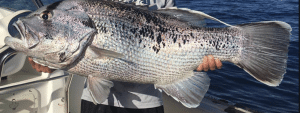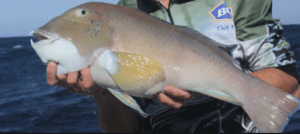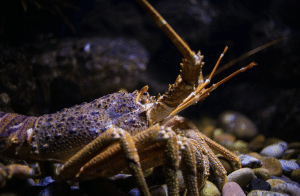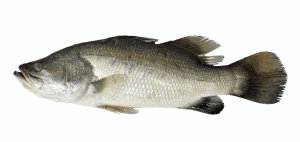With more than 2500 different fish species and dozens of delectable crustaceans living within the waters along the vast Western Australian coastlines finding the most popular ones for sport fishing was a difficult test. We decided to look at beach fishing, pier and jetty fishing, and deep-sea fishing and determined the most popular fish and crustacean sought by the various styles of fishing and where the favourite locations are. We have added the most popular way to cook and enjoy your prized catch.
Helpful Information and Guidelines
Handling of Recreationally Caught Fish for Tourists
It is worth noting that if you are a visiting fisherman and are staying at a commercial accommodation that provides meals in their restaurant, the establishment can now store your recreationally caught fish and have it cooked by their chef. Your fish will must be labelled with your full name and home address. Be sure to ask if there is any charge for this service. Recreational Fishing Guide
For all the latest information on your obligations regarding fishing licenses, license fees, bag and size limits per species, protected areas, closed seasons for specific species, general fishing rules, fishing safety tips, and more related topics, please read the Recreational Fishing Guide provided by the Western Australia Government, Department of Fisheries.
Personal Safety Equipment when Fishing
Regardless of the way that you choose to do your fishing, you will want to bring the following items to protect yourself from environmental hazards.
- A hat with a full brim to protect your head and protect against sun glare
- A sunscreen with SPF 30 or above to protect your face and any exposed skin
- A pair of sunglasses to deflect the glare of the sun from above and reflected on water surfaces
- A lightweight jacket to protect you when fishing in windy locations
- Wear a pair of non-slip shoes if fishing from a pier, jetty, or a boat
- Wear a pair of flip-flops when beach fishing to protect the soles of your feet from blistering
- Carry seasickness tablets if fishing from a boat and you are sensitive to wave movements
- Loose, comfortable clothing that lets you move with ease when reeling in your catch
-
Waders or high water boots if fishing in streams or lakes Fishing Equipment
While it may be obvious, always check and double-check that you have packed your fishing license and all of the fishing gear, bait, and ice coolers that you will need to both catch and store your fish. When going on a fishing charter trip, the charter crew takes the guesswork out of what equipment you’ll need for a successful day of deep-sea fishing.
The charter will have all the required licenses, the fishing gear, the rods and reels, the bait, and ice, and leak-proof bags to store your fish for the trip back to your hotel or home.
Most Popular Fish to Catch by Beach Fishing
The beauty of beach fishing is that all you need is a small piece of the beach, a fishing pole, a beach chair, and a sunny day. You can either plant your pole in the sand, sit back and wait, or stand in the cooling water with your line out in front of you and wait. Either way, you’ll have a relaxing adventure that is ideal for beginners and seasoned fishermen.
Western Australian Dhufish
The Dhufish are highly-valued iconic Western Australian fish that are not found anywhere else in the world.
Where to find Dhufish:
The Dhufish are uniquely Western Australian fish and members of the Glaucosomatidae species, which is the pearl perches. Normally, you need to use a boat to go out into deeper waters to catch Dhufish, but you can actually reel them in along the beach line at Two Rocks, located in the northern section of Perth.
How to Cook Dhufish:
The Dhufish are large in size, have plenty of flesh, and tastes superb when marinated in your favourite sauce and cooked on an open grill. Add a baked potato and a tossed salad, and you’ll know what a true delight it is to dine on a genuine Western Australian icon.
Out of Season Fishing for Dhufish:
The Dhufish is part of the Western Australian sustainability fishery program. This means that from mid-October to mid-December, during their mating season, it is illegal to catch Dhufish.
King George Whiting
Where to find King George Whiting:
King George Whiting are plentiful along the Western and Southern coastal lines of Western Australia. The preferred methods for catching these fish are nearshore or estuary fishing and beach fishing. One excellent location for beach fishing is Middleton Beach in Augusta. King George Whiting practically jump into your lap.
How to cook King George Whiting:
Clean and de-bone your King George Whiting. Cut into fillets. Dip the fillets into beaten eggs and cover with plain flour or fish crumbs. Place in a non-stick frying pan that has been heated and has a layer of melted real butter for frying. Cook about 1-2 minutes on each side. Remove from the pan and place on a dish. Spoon the melted butter over the fish, sprinkle with parsley, oregano, and fresh lemon juice. Serve with asparagus spears, brown rice, and sliced tomatoes for a mouth pleasing meal.
Most Popular Fish to Catch by Pier or Jetty Fishing
Throughout the coastal lines of Western Australia, there are some amazing piers and jetties where popular species of fish and crustaceans can be caught. Just bring your fishing line and some patience to take advantage of this style of fishing.
Baldchin Groper
The Baldchin Groper are an amazing, totally unique Western Australian fish sought for their abundance of high-quality white flesh and their delicious flavour. Like other inshore demersal species, the Baldchin Groper have a closed fishing season from mid-October to mid-December for sustainability management while they are spawning.
The Baldchin Groper are members of the tusk fish family and easily identified by their white chins and the white patches on their pectoral fins. These fish are sequential hermaphrodites that change their sex from female to male midway through their 25-year life cycle.
Where to find Baldchin Groper:
The adult fish are more commonly caught in deep waters while the young gravitate to shallower waters around the rocks and around jetties. They are found in abundance from north of Kalbarri to the east of Augusta. The younger Baldchin Groper can be caught off the highly popular Busselton Jetty in the town of Busselton. The Baldchin Groper are affectionately called Baldies by the locals. These fish are powerful swimmers and are known to put up a good struggle when caught on a fishing line. Their tusk-like teeth also enable them to cut through fish lines. They are a great recreational fishing challenge.
How to cook Baldchin Groper:
The Baldchin Groper have a natural, tasty flavour that makes them a favourite amongst the Western Australian residents. When cleaned, de-boned, and cut into fillets, the Baldchin Groper is mouthwatering when lightly fried in a frying pan with melted butter, shallots, and fresh chopped garlic. Before placing the fillets in the frying pan, dip them in beaten eggs and coat them in a light flour or in seasoned crumbs. Fry the fillets about 2-3 minutes on each side, remove the fillets from the pan and place on plates garnished with parsley. Serve with your favourite side dish of rice, baked potato, sweet potato or roasted pepper. Add a small tossed salad and a crusty dinner roll for a meal that lingers on your tongue and in your memory.
Western Rock Lobster – Crayfish
The most popular of the various eight members of the rock lobster family is the Western Rock Lobster. They are locally called Crayfish and are the largest, most valuable lobster in the area’s fishing industry. They are found all along the coastal shelf of Western Australia, with the abundance of Crayfish dwelling in the waters between Perth and Geraldton on the west coast. At the current time, the supply of Crayfish is at a level that permits year-round catching.
Where to find Western Rock Lobster – Crayfish:
One favourite location for capturing large Crayfish is the Lancelin Jetty in the seaside town Lancelin, an hour and a half drive from Perth. You can drop your lobster pot off of the jetty at dusk and return at dawn to pull in your catch. There is no license required to fish off of the jetty.
How to cook Western Rock Lobster – Crayfish:
Bring a large pot of salted water to a boil. Then, after you have drowned the Crayfish in freshwater, drop it into the pot and bring the water back to a boil. Depending on the size of the Crayfish, you’ll want to boil an average size Crayfish for 6 to 8 minutes, while a larger Crayfish will require a few minutes more for thorough cooking. Once you take the Crayfish out of the pot, put it into cold water to stop the cooking process. Once the Crayfish has been broken open, remove the meat and dip it in melted butter for an unforgettable outstanding taste. Typical side dishes are potato salad, cucumber salad, or a baked potato.
If you want to try barbequing your Crayfish, you’ll be tempted to try this recipe provided by top chef Kiren Mainwaring, the owner of two hot Perth restaurants, the Co-op Ding and Dear Friends.
Most Popular Fish to Catch by Deep Sea
Nothing brings out the angler spirit in fishermen of all levels than the thrill of deep-sea fishing. There is the excitement of the adventure and the challenge of man versus the sea. And, Western Australia’s coastal sea waters magnanimously fulfils this expectation. Pairing the selection down to two popular fish to seek out in the deep waters was tough. But, our selections were based on conversations with a number of avid local fishermen.
Barramundi
The Barramundi are members of the sea perch family and are prized icons of Western Australian fish. The Barramundi are highly-valued by recreational fishermen for their fighting spirit when hooked and for their great tasting meat. Like the Baldchin Groper, the Barramundi are sequential hermaphrodites, and that means that they change their sex from male to female midway through their 22-year life cycle. They live in both fresh and salt waters and also known as Asian sea bass or giant sea perch. They are born in saltwater, migrate to fresh water while they are young, and then return to the salt water when they are ready for spawning.
Where to find Barramundi:
In Western Australia, Barramundi are found in the waters from Exmouth Gulf northward. The most populated area for Barramundi is in the Kimberley region where you are required to have an Inland Fisherman’s License. A license can be granted by the Fisheries and Wildlife administration offices in Broome and Wyndham or from the courthouses in Kununurra and Derby. Any river in and around the Kimberley region with access to sea waters will have Barramundi. If you don’t have your own boat, your best option is to sign up for a charter fishing tour.
How to cook Barramundi:
Without question, Barramundi are tasty and a Western Australian favourite that are found on many restaurant menus. One easy, flavorful, and delectable way to cook Barramundi is on a grill. Use foil to wrap Barramundi fillets with black olives, chopped tomatoes, sea salt, pepper, and oregano. Place them on the grill for about 30 minutes. Unwrap the fillets and put them on plates. Serve with a local white wine for an exquisite lunch or dinner.
If you are looking for locally favourite Barramundi recipes, check out the half dozen recipes offered by the chefs at Australian Sustainable Barramundi.
Bottom Line
Styles of fishing, from the beaches to the deep waters, are as varied as the type of fish being sought. Whether you are a beginner or a lifelong fisherman, the waterways, shorelines, piers, jetties, and even rock walls will have a fish or crustacean to meet your expectations. Enjoy the adventure and relish the meals made from your treasured catches.





